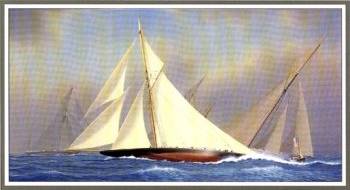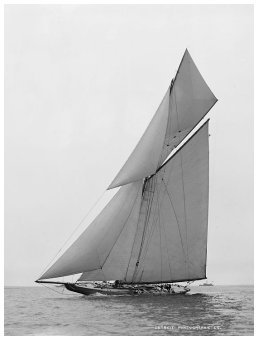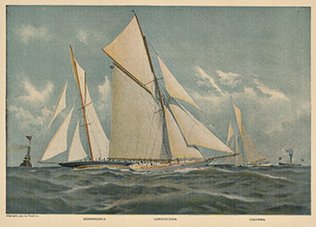Yves GARY Hits: 5332
Category: INDEPENDENCE
 Work on the Constitution was no sooner under way at the Herreshoff shop than word came that Boston would also be in the field to dispute the new boat's right to the honor of defending. It had been eight years since Boston had been represented by a Cup yacht and this word came with something of a shock to the complaisance of the two New York Yacht Club syndicates and was received with poor grace.
Work on the Constitution was no sooner under way at the Herreshoff shop than word came that Boston would also be in the field to dispute the new boat's right to the honor of defending. It had been eight years since Boston had been represented by a Cup yacht and this word came with something of a shock to the complaisance of the two New York Yacht Club syndicates and was received with poor grace.
The owner of the Boston boat was Thomas W. Lawson, a rich stock broker and speculator, possessed of ample means to build the boat alone and do her justice. He was not a practical yachtsman, however, and, besides, he was not a member of the New York Yacht Club.
 Now, the New York Yacht Club had held a monopoly on Cup defense so long that it had construed the various Deeds of Gifts to imply that the defending boat must belong to a member of the Club and sail under the Club burgee. Every boat that had so far represented this country in these matches had done so; and while there was nothing specific on this point in any of the three Deeds, the fact that the last Deed specifically made over the Cup to the New York Yacht Club, to be held by it until won by a foreign club, made the Club feel that it was responsible for the defense and it was not right to make it assume this responsibility unless it had complete control of the yacht chosen to defend. It could only have this control if the yacht were owned in the club. This may have been roundabout reasoning, but still it must be remembered that the Cup was in the possession of the New York Yacht Club, and possession implies a good deal in yacht racing. The Club's attitude in this matter did not find favor in the eyes of the majority of the American public, yet it must be said that it was in keeping with racing custom, and no club holding a cup would ever look to another club to supply a defender.
Now, the New York Yacht Club had held a monopoly on Cup defense so long that it had construed the various Deeds of Gifts to imply that the defending boat must belong to a member of the Club and sail under the Club burgee. Every boat that had so far represented this country in these matches had done so; and while there was nothing specific on this point in any of the three Deeds, the fact that the last Deed specifically made over the Cup to the New York Yacht Club, to be held by it until won by a foreign club, made the Club feel that it was responsible for the defense and it was not right to make it assume this responsibility unless it had complete control of the yacht chosen to defend. It could only have this control if the yacht were owned in the club. This may have been roundabout reasoning, but still it must be remembered that the Cup was in the possession of the New York Yacht Club, and possession implies a good deal in yacht racing. The Club's attitude in this matter did not find favor in the eyes of the majority of the American public, yet it must be said that it was in keeping with racing custom, and no club holding a cup would ever look to another club to supply a defender.
Mr. Lawson was informed soon after he started to build of the interpretation the New York Yacht Club placed on the trust by which it held the Cup, and that if he wanted to race this boat in the trial races to pick a defender, he would have to either join the New York Yacht Club, or put his boat temporarily in the possession of some member of that Club.
Mr. Lawson was a very aggressive and outspoken man, and he declined to comply with these suggestions. He told the committee who saw him in regard to this matter, when they intimated that he might have a boat -on his hands and nothing to race against, that that was his concern and not theirs.
Thus the yachting season opened with three big sloops in the field, considerable hard feeling, and every prospect of a lively time. It is needless to say that the prospect was fulfilled.
Independence was launched at the Atlantic Works, East Boston, May 18th, at 11 r. m. On her first trial under sail June 3d in a moderate breeze she showed a fair turn of speed, and seemed to bear out the predictions that she would prove fast enough to trouble the Bristol boats when they should meet her off Newport, as all three yachts were entered for a special series of races there beginning July 6th.
While this matter of choice was bothering the America's Cup Committee in mid-season, the Boston sloop, which had been named Independence, arrived off Newport, after a rough voyage around Cape Cod at the end of a towing hawser.
 During the first two races on 6th and 8th July, Independence was completely outclassed. On July 11th, after some modifications, he finished third, 6 minutes 18 seconds behind Columbia and 2 mn 58 s behind Constitution, these results show a significant improvement of the boat. The next day, on July 12th, Independence achieves a remarkable performance. After losing her topmast near the start, he finished only 10 minutes 44 s behind Columbia and 8 min 25 sec behind Constitution.
During the first two races on 6th and 8th July, Independence was completely outclassed. On July 11th, after some modifications, he finished third, 6 minutes 18 seconds behind Columbia and 2 mn 58 s behind Constitution, these results show a significant improvement of the boat. The next day, on July 12th, Independence achieves a remarkable performance. After losing her topmast near the start, he finished only 10 minutes 44 s behind Columbia and 8 min 25 sec behind Constitution.
After a stay in dry dock in Bristol, Independence races against Columbia on August 1st, Constitution was being repaired. He loses the race for 5 min 14 s.
For the last race of his short career, on August 3rd, Independence achieves another remarkable performance. Over a course of 30 miles, he finished only 1 minute 35 seconds behind his rival, also beating the record times for sailing in twenty miles.
"I did everything possible to secure a race or series of races for her with any or all the boats of her class then afloat, the Shamrock I. and Shamrock II, the Columbia and Constitution. I even offered to keep her in commission beyond the season of 1901 provided I was assured she would have an opportunity of racing against all or any of the above boats."
"When I became convinced it would be impossible for her to secure another race, and that there was absolutely no reason for keeping her afloat, I gave orders that she be broken up."
Independence was in commission exactly three months. Her sails were hoisted for the first time off Boston light June 3d, and on September 3d they were lowered for the last time, in the same locality. The work of breaking up the yacht began as soon as she went out of commission, and in a month a pile of metal in a corner of a boat-shop at Lawley's yard was all that remained of her hull.
 |
Three dates marked the short career of Independence :
|
